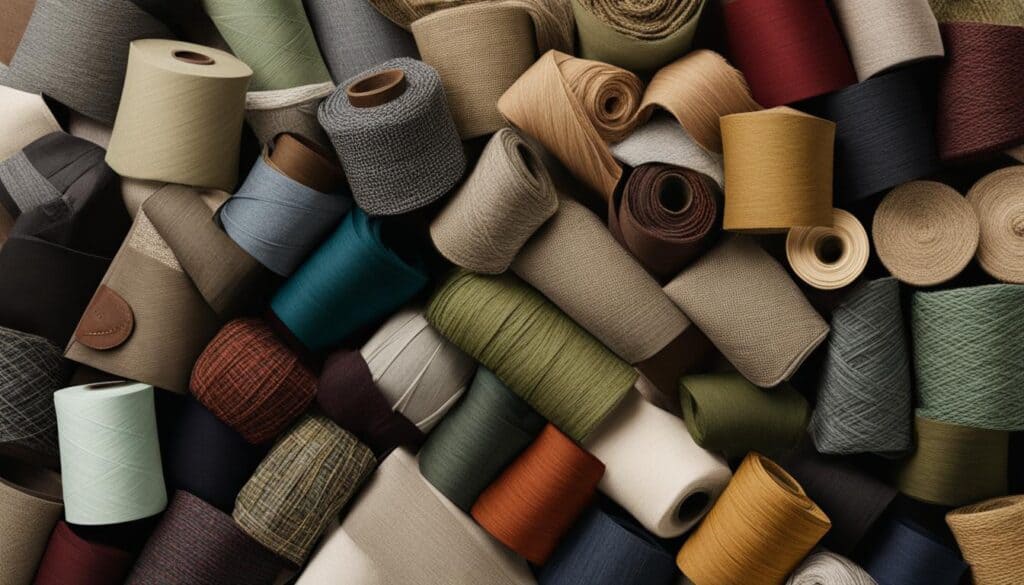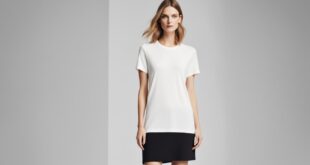The fashion industry is undergoing a transformative shift as sustainable fashion trends gain momentum in the United States. The rise of eco-chic sustainable fashion represents a growing movement towards more environmentally friendly and ethical fashion choices. Consumers are increasingly seeking clothing options that not only make a style statement but also contribute to a greener future.
As awareness of the negative impact of fast fashion on the environment grows, more individuals are consciously opting for eco-friendly fashion. Sustainable fashion trends encompass a range of practices, including the use of organic and recycled materials, fair trade practices, and a focus on reducing waste in the production process.
Key Takeaways:
- Sustainable fashion is on the rise as consumers prioritize environmentally friendly and ethical choices.
- Trends in sustainable fashion include the use of organic and recycled materials, fair trade practices, and waste reduction.
- The fashion industry has the potential to contribute to a greener future through sustainable practices and consumer demand.
- By embracing sustainable fashion, individuals can make a positive impact and join the green fashion revolution.
- The future of the fashion industry lies in the hands of those who support ethical and environmentally conscious clothing choices.
Sustainable Materials and Fabrics

In the world of sustainable fashion, the materials and fabrics used are key in reducing the industry’s environmental impact. Brands are now turning to eco-friendly fabrics and organic materials to create stylish, yet sustainable clothing options for consumers.
Organic cotton, hemp, and bamboo are becoming increasingly popular choices for sustainable fashion brands. These materials are grown without the use of harmful chemicals and pesticides, making them more environmentally friendly. They also offer consumers clothing that is not only stylish but also durable, as these natural materials are known for their quality and longevity.
In addition to organic materials, recycled fabrics are also gaining traction in the sustainable fashion industry. Brands are finding innovative ways to reuse materials, such as recycled polyester and upcycled fabrics, to reduce waste and minimize their environmental impact. By repurposing materials that would otherwise end up in landfills, sustainable fashion brands are creating unique and eco-friendly clothing options for consumers.
The Benefits of Sustainable Materials and Fabrics
- Eco-friendly fabrics reduce the use of harmful chemicals and pesticides
- Organic materials offer durability and longevity
- Recycled fabrics help reduce waste and minimize environmental impact
- Sustainable materials provide unique and stylish clothing options
By opting for sustainable materials and fabrics, consumers can make a positive impact on the environment while still enjoying fashionable clothing that aligns with their values. The use of organic and recycled materials in the fashion industry is a significant step towards creating a more sustainable future.
Ethical Manufacturing Practices

When it comes to sustainable fashion, ethical manufacturing practices are of utmost importance. Brands are now more committed than ever to ensuring fair trade and supply chain transparency. By prioritizing ethical manufacturing, the fashion industry can make significant strides towards sustainability.
1. Fair Trade
Fair trade practices are a key aspect of ethical fashion. This involves ensuring that workers receive fair wages and are provided safe working conditions. By supporting brands that prioritize fair trade, consumers can contribute to a more just and equitable fashion industry.
2. Supply Chain Transparency
Supply chain transparency is another crucial consideration in ethical manufacturing. Brands are now providing detailed information about the origins of their materials and the production process. This transparency helps consumers make informed choices and hold brands accountable for their practices.
3. The Importance of Ethical Fashion
Choosing ethical fashion goes beyond making stylish choices. It is a way to support the well-being of garment workers and minimize the negative impact of the fashion industry on both people and the planet. By embracing ethical manufacturing practices, the fashion industry can pave the way for a more sustainable and socially responsible future.
With a growing emphasis on ethical fashion, consumers have the power to drive change and advocate for a more sustainable industry. By choosing brands committed to fair trade and supply chain transparency, individuals can make a positive impact and contribute to a greener future.
Slow Fashion Movement

The slow fashion movement is gaining traction as a response to the negative impacts of fast fashion. It encourages conscious consumption and promotes the idea of quality over quantity. Slow fashion advocates for investing in high-quality, timeless pieces that are made to last, rather than constantly buying cheap, disposable clothing.
One of the key principles of the slow fashion movement is reducing waste. By opting for durable garments and taking care of them, we can extend their lifespan and minimize the amount of clothing that ends up in landfills. This approach not only benefits the environment but also allows us to build a more sustainable wardrobe that reflects our personal style.
The slow fashion movement emphasizes the importance of mindful shopping and encourages consumers to ask questions about the origin and production process of their clothing. By supporting brands that prioritize ethical practices, we can contribute to a more sustainable and socially responsible fashion industry.
The Benefits of Slow Fashion:
- Environmental impact reduction
- Support for ethical practices
- Longer-lasting wardrobe
- Defined personal style
By embracing the slow fashion movement, we can make a positive impact on the fashion industry and the planet. Together, let’s choose quality over quantity and redefine our relationship with clothing.
Circular Fashion Economy

The circular fashion economy is revolutionizing the way we perceive and consume fashion. It is a sustainable approach that aims to minimize waste and maximize resource efficiency in the fashion industry. At the heart of this movement lies the concept of circularity, where clothing is recycled and materials are reused or upcycled, creating a closed-loop system.
Brands are taking significant steps towards promoting a circular fashion economy. Many are implementing clothing recycling programs, encouraging customers to return their old garments. These recycled materials are then transformed into new, fashionable pieces, reducing the need for virgin resources and minimizing environmental impact.
Furthermore, upcycling has gained popularity as a creative and sustainable way to repurpose old or unwanted clothing. Designers are breathing new life into garments by transforming them into unique and stylish pieces. Upcycling not only reduces waste but also promotes individuality and creativity within the fashion industry.
The circular fashion economy offers a promising solution to the environmental challenges posed by the fashion industry. By embracing clothing recycling and upcycling, we can contribute to a more sustainable future where fashion is both stylish and eco-friendly.
Sustainable Fashion Innovation: Embracing Tech-Driven Fashion and Smart Textiles
The world of sustainable fashion is constantly evolving, driven by innovative design and cutting-edge technology. Brands are pushing the boundaries of eco-friendly fashion, exploring new possibilities to create more sustainable clothing options. This section explores the exciting realm of sustainable fashion innovation, from tech-driven fashion to the rise of smart textiles.
Technology is revolutionizing the fashion industry, enabling brands to incorporate sustainable practices into their design and production processes. 3D printing, for example, allows for precise customization and reduces material waste. Laser cutting techniques create intricate patterns while minimizing fabric waste. Digital textile printing eliminates the need for excessive water usage and harmful chemical dyes. These tech-driven approaches not only promote sustainability but also offer unique design possibilities.
Inspiring Quote:
“Technology allows us to rethink traditional fashion practices, enabling us to create beautiful, sustainable garments without compromising on style or quality.” – Sustainable Fashion Designer
Another exciting area of sustainable fashion innovation is the emergence of smart textiles. These fabrics are infused with sensors and wearable technology, bringing functionality and innovation to the forefront of fashion. Smart textiles can monitor heart rate, body temperature, and even measure UV exposure. They offer endless possibilities for sustainable fashion, combining style with practicality.
Sustainable fashion innovation, driven by technology and smart textiles, is shaping the future of the industry. As brands continue to explore these advancements, the possibilities for eco-friendly fashion are expanding. By embracing tech-driven approaches and incorporating smart textiles into their collections, sustainable fashion brands are not only reducing their environmental impact but also revolutionizing the way we think about clothing.
Sustainable Fashion Collaborations: Driving Change in the Industry
In the ever-evolving landscape of sustainable fashion, collaborations have emerged as a powerful tool for driving change. Through brand partnerships, industry collaboration, and influential figures joining forces, the fashion industry is making significant strides towards a more sustainable future.
One of the key benefits of sustainable fashion collaborations is the amplification of sustainability messages. When brands with a shared commitment to eco-friendly practices come together, their collective voice becomes stronger, reaching a wider audience and inspiring more people to make conscious fashion choices.
Brand partnerships
Brand partnerships, whether between sustainable fashion labels or collaborations between sustainable and mainstream brands, have the potential to transform the industry. These collaborations often aim to create unique, eco-friendly collections that showcase sustainable materials and ethical manufacturing practices. By merging creativity and sustainability, these partnerships demonstrate that style and sustainability can coexist.
Collaborative efforts increase awareness and encourage consumers to make more sustainable fashion choices.
Industry collaboration
Collaboration within the fashion industry is crucial for driving systemic change. As more brands, designers, and industry stakeholders come together, they can collectively address challenges such as supply chain transparency, fair trade practices, and the adoption of sustainable materials. Through shared knowledge and resources, industry collaboration paves the way for a more sustainable and socially responsible fashion industry.
Fashion Activism and Advocacy
Fashion activism and advocacy are powerful tools for driving change in the sustainable fashion industry. Social influencers, activists, and organizations are using their platforms to raise awareness about the environmental and social impacts of the fashion industry. They are shining a spotlight on the need for more sustainable practices and pushing for policy changes at both the industry and governmental levels.
Through their advocacy efforts, these influencers and organizations are encouraging consumers to make conscious fashion choices and supporting brands that prioritize sustainability. They are highlighting the importance of considering the lifecycle of clothing, from production to disposal, and emphasizing the need for transparency in the supply chain.
By leveraging their influence and platforms, fashion activists and advocates are inspiring positive change within the industry and pushing for a more sustainable future. Their efforts are creating a ripple effect, encouraging both consumers and fashion brands to reevaluate their practices and make more environmentally and socially responsible choices.
The Power of Fashion Activism
“Fashion activism has the power to change the world,” says renowned environmental activist Jane Smith. “It allows us to use our love for fashion as a vehicle for social and environmental change. By advocating sustainability and supporting brands that align with our values, we have the power to transform the fashion industry.”
Environmental Awareness through Fashion
Environmental awareness is at the core of fashion activism. Through their campaigns and initiatives, fashion activists and advocates are raising awareness about the environmental impact of the fashion industry, from pollution and carbon emissions to water waste and chemical usage. They are empowering consumers to make informed choices and encouraging them to support brands committed to sustainability.
A Call to Action
The fashion industry has a significant role to play in creating a greener future. Fashion activists and advocates are calling for collaboration between brands, influencers, and consumers to drive change. By joining forces, they can amplify their message and create a collective impact that can transform the industry. It is a call to action for all stakeholders to prioritize sustainability and work towards a more environmentally and socially conscious fashion industry.
Sustainable Fashion Events and Initiatives
Sustainable fashion events and initiatives are playing a vital role in promoting eco-friendly fashion and raising awareness among consumers. These events serve as platforms for showcasing sustainable collections and highlighting the work of ethical fashion brands. Eco-friendly fashion shows, in particular, have gained popularity in recent years, featuring clothing made from sustainable materials and innovative design techniques.
One such example is the Eco Fashion Week, a renowned event that showcases sustainable fashion and educates attendees about the importance of conscious consumption. This event brings together designers, industry professionals, and fashion enthusiasts to celebrate and promote sustainable fashion. Through runway shows, panel discussions, and networking opportunities, Eco Fashion Week provides a platform for sustainable fashion brands to gain exposure and connect with like-minded individuals.
In addition to fashion shows, fashion sustainability campaigns are another way to educate and engage consumers in sustainable fashion practices. These campaigns aim to raise awareness about the environmental impact of the fashion industry and provide resources for making more sustainable fashion choices. They often utilize social media platforms and collaborate with influencers to reach a wider audience. By leveraging the power of social media and digital platforms, these campaigns inspire and empower individuals to embrace sustainable fashion.
Innovative Concepts and Collaborations
Apart from fashion shows and sustainability campaigns, various other initiatives are driving the sustainable fashion movement forward. The Swap and Shop events encourage consumers to exchange their gently used clothing and accessories, promoting circular fashion and reducing textile waste. Pop-up shops featuring sustainable brands provide a unique shopping experience for consumers to discover and support eco-friendly fashion.
Collaborations between sustainable fashion brands and creative individuals have resulted in unique and impactful initiatives. For example, the Red Carpet Green Dress campaign collaborates with renowned actors and designers to create sustainable red carpet gowns, showcasing the possibilities of eco-friendly fashion in high-profile events. These initiatives not only raise awareness among celebrities and the general public but also challenge the notion that sustainable fashion compromises style.
Overall, sustainable fashion events and initiatives create a sense of community and inspire individuals to embrace a more eco-friendly and conscious approach to fashion. By attending these events, engaging with sustainability campaigns, and supporting ethical fashion brands, consumers can contribute to the growth of sustainable fashion and make a positive impact on the environment.
The Future of Eco-Friendly Fashion: Meeting Consumer Demand and Driving Sustainable Fashion Market Growth
Consumer demand for sustainable fashion is shaping the future of the industry, driving a shift towards more ethical and environmentally friendly clothing choices. As consumers become increasingly aware of the negative impact of fast fashion, they are seeking out sustainable alternatives that align with their values. This rising demand has created a market for eco-friendly fashion that is expected to continue growing in the coming years.
With sustainability at the forefront, brands are incorporating eco-friendly practices into their business models. From using sustainable materials like organic cotton and recycled polyester to embracing ethical manufacturing and supply chain transparency, the fashion industry is evolving to meet the demands of conscious consumers. This shift towards sustainability is not only beneficial for the environment but also for the long-term success of fashion brands that prioritize ethical and eco-friendly practices.
The future of eco-friendly fashion holds immense potential for market growth and innovation. As consumers continue to prioritize sustainability, brands will need to adapt and innovate to stay competitive. This includes exploring new technologies and materials, collaborating with industry partners, and engaging in fashion activism and advocacy to drive systemic change. By embracing sustainability as a core value, the fashion industry can create a greener future and meet the evolving needs of environmentally conscious consumers.
The Rise of Sustainable Fashion Influencers
Influencers play a significant role in shaping consumer demand for sustainable fashion. Social media platforms have provided a platform for individuals to share their sustainable fashion journeys and inspire others to make more conscious fashion choices. Sustainable fashion influencers showcase eco-friendly brands, provide styling tips for second-hand clothing, and advocate for the importance of sustainability in the fashion industry. Their influence continues to grow, driving consumer awareness and demand for sustainable fashion.
The Power of Consumer Education
Education and awareness are key components in driving consumer demand for sustainable fashion. Through educational initiatives, fashion sustainability campaigns, and transparent brand communication, consumers are empowered to make informed choices and actively support eco-friendly brands. Consumer education efforts can highlight the environmental and social impact of the fashion industry, encouraging consumers to consider the lifecycle of their clothing and make more sustainable purchasing decisions.
“The future of eco-friendly fashion lies in the hands of consumers who prioritize ethical and environmentally friendly clothing choices.” – Sustainable Fashion Advocate
The Importance of Collaboration
Collaboration between brands, influencers, and industry stakeholders is crucial in driving the future of sustainable fashion. By coming together, they can amplify their sustainability messages and make a greater impact. Collaborative efforts can lead to the development of new sustainable materials, innovative eco-friendly technologies, and the sharing of best practices. Through collaboration, the fashion industry can create a united front in the pursuit of a more sustainable and socially responsible future.
Fashion’s Role in Creating a Greener Future
The fashion industry’s impact on the environment is a significant concern, but it also has the potential to contribute to a greener future. By adopting sustainable practices, reducing waste, and promoting ethical manufacturing, the fashion industry can become a driving force for positive change. Despite its challenges, fashion’s contribution to sustainability is being recognized, and efforts are being made to create a greener fashion industry.
The fashion industry’s impact on the environment is vast and includes issues such as water pollution, greenhouse gas emissions, and textile waste. However, by incorporating sustainable materials, such as organic cotton and recycled fabrics, fashion brands can reduce their environmental footprint. Additionally, ethical manufacturing practices, such as fair trade and supply chain transparency, ensure that workers are treated fairly and working conditions are safe.
“Sustainability is no longer an option; it’s a necessity for the fashion industry. We have a responsibility to protect our planet and promote ethical practices.” – Fashion Industry Expert
The fashion industry has the power to influence consumer behavior, and as consumers become more aware of the environmental impact of their choices, they are demanding greener alternatives. By embracing sustainable fashion, consumers can contribute to a greener fashion industry and support brands that prioritize ethical and sustainable practices.
Fashion’s Potential for Change
With the collective efforts of fashion brands, consumers, and industry stakeholders, the fashion industry can pave the way for a greener future. Collaboration is key in driving change, and partnerships between sustainable fashion brands, influential figures, and organizations can amplify sustainability messages and create unique, eco-friendly collections.
Fashion activism and advocacy are also instrumental in promoting sustainable fashion. Social influencers, activists, and organizations are raising awareness about the environmental and social impacts of the fashion industry, advocating for more sustainable practices, and inspiring consumers to make conscious fashion choices.
Together, these efforts can transform the fashion industry into a catalyst for environmental sustainability, creating a greener future where style and sustainability go hand in hand.
Conclusion
The rise of eco-chic sustainable fashion in the U.S. signifies a significant shift in consumer preferences towards more ethical and environmentally friendly clothing choices. With the growing awareness of the negative impact of fast fashion on the environment, consumers are seeking out sustainable fashion options that align with their values.
Sustainable fashion brands are embracing eco-friendly materials such as organic cotton, hemp, and recycled fabrics, reducing their environmental footprint while still offering high-quality and durable clothing options. Ethical manufacturing practices are also becoming a priority, with fair trade practices and supply chain transparency being key considerations for brands.
The future of sustainable fashion looks promising, with the potential for a greener fashion industry that values both style and sustainability. Collaborations, fashion activism, and consumer demand are driving positive change within the industry. By making conscious fashion choices, consumers can contribute to the growth of sustainable fashion and join the green fashion revolution.
 Fullersears
Fullersears





